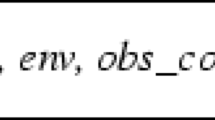Abstract
The principal aim of this study was to show how an autonomous mobile robot can acquire the optimal action to avoid moving multiobstacles through interaction with the real world. In this paper, we propose a new architecture using hierarchical fuzzy rules, a fuzzy evaluation system, and learning automata. By using our proposed method, the robot autonomously acquires finely tuned behavior which allows it to move to its goal and avoid moving obstacles by using the steering and velocity control inputs simultaneously. We also show experimental results which confirm the feasibility of our method.
Similar content being viewed by others
Explore related subjects
Discover the latest articles, news and stories from top researchers in related subjects.References
Narendra K, Thathachar MAL (1989) Learning automata. Prentice-Hall, Englewood Cliffs
Aoki T, Matsuno M, Suzuki T, Okuma S et al. (1994) Motion planning for multiple obstacles avoidance of autonomous mobile robot using hierarchical fuzzy rules. IEEE International Conference on Multisensor Fusion and Integration for Intelligent Systems pp 265–271
Maeda Y, Takegaki S (1988) Collision avoidance control among moving obstacles for a mobile robot on the fuzzy reasoning (in Japanese). J Robotics Soc Jpn 6: 518–522
Author information
Authors and Affiliations
Corresponding author
About this article
Cite this article
Aoki, T., Oka, T., Hayakawa, S. et al. Experimental study on autonomous mobile robot acquiring optimal action to avoid moving obstacles. Artificial Life and Robotics 1, 205–210 (1997). https://doi.org/10.1007/BF02471141
Received:
Accepted:
Issue Date:
DOI: https://doi.org/10.1007/BF02471141




